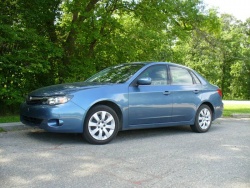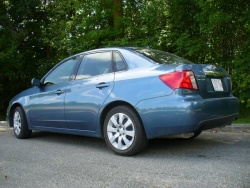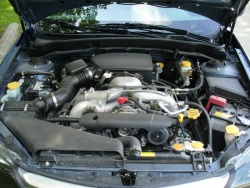 2010 Subaru Impreza 2.5i sedan. Click image to enlarge |
|
Related articles on Autos
Manufacturer’s web site
|
Review and photos by Haney Louka
Photo Gallery:
2010 Subaru Impreza
Subaru’s entry-level model was redesigned for the 2008 model year and soldiers on essentially unchanged. Even so, I was looking forward to taking this one for a week-long spin. The reason for my enthusiasm was that Subaru bravely decided to send through a bare-bones four-door sedan with a manual transmission and exactly zero options. Sending us a base model helps us focus on a particular model’s intrinsic properties without being distracted by more powerful engines or fancy sound systems. And sadly, press cars with manual transmissions are becoming a rare sight in our nation’s press fleets.
So here it is, the $20,995 Subaru Impreza 2.5i. You could shell out another $1,100 for the four-speed slushbox, but that would be like placing a sushi order with only cooked ingredients: what’s the point?
The Impreza is one of those rare cars that has actually become less expensive over the years: going back into my road test archives, I found that the 2002 Impreza TS started at $21,995.
 2010 Subaru Impreza 2.5i sedan. Click image to enlarge |
So even though the Impreza once commanded a hefty premium compared with its competitors, the current model is priced much more aggressively when measured against its peers. Chief among the features that make up the Impreza’s value proposition is the presence of standard all-wheel drive; a feature that can’t be had on its more mainstream competitors like the Mazda3 and Volkswagen Jetta. While there are several other cars in this highly competitive class, I name those two as prime competition because of the higher take rate of manual transmissions compared with others in this class.
The Japanese automaker makes much of the Impreza’s rally-bred all-wheel drive system, which splits power evenly between front and rear axles until decreased traction dictates otherwise, at which time the viscous limited-slip centre differential directs power to the wheels with more grip.
Other standard features on the Subie include four-wheel disc brakes, fully independent suspension, air conditioning, steering-wheel mounted cruise control, two power outlets, power windows with driver’s auto down, remote keyless entry, dual mufflers, a strut-supported hood, 16-inch steel wheels with plastic covers, a trip computer, side curtain airbags, and electronic stability control.
 2010 Subaru Impreza 2.5i sedan. Click image to enlarge |
For 2011, the Impreza line gains larger rear-seat head restraints and new option packages that incorporate Bluetooth hands-free connectivity and higher-end sound systems.
As is expected from Subaru, under the Impreza’s hood is a horizontally-opposed four-cylinder “boxer” engine that displaces 2.5 litres. This flat configuration has long been one of Subaru’s trademarks (their six-cylinder models also share this horizontally-opposed piston arrangement) and continues to help define the character of the car. Subaru asserts that their boxer engine sits lower in the engine compartment, contributing to an overall lower centre of gravity for the car. For me, the primary benefits are its torquey nature and the unique growl of the flat-four under acceleration. Power output for the mill is rated at 170 hp and 170 lb-ft of torque: figures that are more in common with optional engines from the Impreza’s competitors.







 Follow Autos on Twitter
Follow Autos on Twitter



